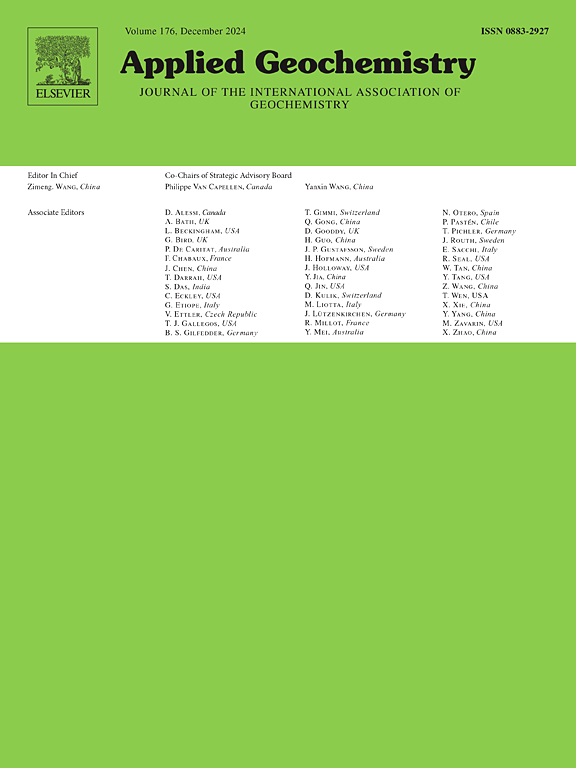Hydrochemical composition and hydrodynamics as proxies to identify the stream water sources and pathways in high-altitude catchments
IF 3.1
3区 地球科学
Q1 GEOCHEMISTRY & GEOPHYSICS
引用次数: 0
Abstract
This study investigates the complex relationship between high-altitude stream hydrochemistry and geochemical processes in the Liddar catchment, a representative high-altitude watershed in the Western Himalayas. High-altitude catchments, like the Liddar, are critical as they are major freshwater sources, heavily influenced by snow and glacier melt contributions, making them particularly sensitive to climate change. The high-altitude location intensifies the seasonal contrast in hydrochemical signatures, driven by glacier and snowmelt inputs, which are distinct from low-altitude catchments that rely more on rainfall. We applied geochemical and bayesian stable water isotope modeling to distinguish the hydrochemical signatures during baseflow and intense melting periods. Across the seasons, stable isotope water analyses outline the diverse contributions of snowmelt, precipitation, and groundwater to streamflow. A large portion of streamflow is sourced from meltwater (62.05 ± 6.24%) in summer that reduces in spring by (51.34 ± 7.43%). In Autumn, meltwater contribution drops to 28.30 ± 7.24% and this contribution further drops significantly to 18.87 ± 3.68% during winter. Conversely, during winter and autumn a larger portion of the stream water is sourced from groundwater (60.45 ± 8.54% and 55.78 ± 7.37%) respectively. Groundwater contribution to baseflow decreases from 37.61 ± 5.58% to 28.91 ± 8.51% in spring and summer respectively. Mean residence time (MRT) of stream water, extending to 13 weeks during baseflow and shortening to 7 weeks during melting conditions, points to dynamic storage and flow path characteristics of the catchment. Geochemical modeling highlights the dissolution of minerals such as calcite, dolomite, and gypsum as key drivers of stream water chemistry. Baseflow period shows enrichment of major ions like calcium, magnesium, bicarbonate and trace elements like Ni and Cr exhibiting geochemical signatures suggestive of deeper flow paths and mineral dissolution from host rock formations. However, the intense melting periods demonstrate significant increase in trace elements like, Al, indicative of shallower sources suggesting interactions between melting snowpacks and regolith. Our study demonstrates that in undisturbed high-altitude watersheds the stream, groundwater, and soil chemistry effectively reflect the flow path dynamics. This research offers critical insights for adaptive water resource management strategies in high-altitude regions, which face unique challenges under changing climatic conditions, such as the mobilization of heavy metals and freshwater toxicity.

以水化学成分和水动力学为指标确定高海拔流域的水源和路径
本文研究了西喜马拉雅地区具有代表性的lidar流域高海拔河流水化学与地球化学过程之间的复杂关系。像lidar这样的高海拔集水区至关重要,因为它们是主要的淡水来源,受到雪和冰川融化的严重影响,使它们对气候变化特别敏感。在冰川和融雪输入的驱动下,高海拔地区加强了水化学特征的季节性对比,这与更依赖降雨的低海拔集水区不同。我们应用地球化学和贝叶斯稳定水同位素模型来区分基流期和强融化期的水化学特征。在整个季节,稳定同位素水分析概述了融雪、降水和地下水对河流的不同贡献。夏季大部分流量来自融水(62.05±6.24%),春季减少(51.34±7.43%)。秋季融水贡献率降至28.30±7.24%,冬季进一步显著下降至18.87±3.68%。反之,冬季和秋季,来自地下水的水量占比较大(分别为60.45±8.54%和55.78±7.37%)。地下水对基流的贡献在春季和夏季分别从37.61±5.58%下降到28.91±8.51%。水流的平均停留时间(MRT)在基流期间延长至13周,在融化条件下缩短至7周,这表明了集水区的动态储存和流动路径特征。地球化学模型强调了方解石、白云石和石膏等矿物的溶解是河流化学的关键驱动因素。基流期钙、镁、碳酸氢盐等主要离子和镍、铬等微量元素富集,地表化学特征显示出较深的流动路径和寄主岩层矿物溶蚀作用。然而,强烈的融化期表明微量元素如Al的显著增加,表明较浅的来源表明融化的积雪和风化层之间的相互作用。我们的研究表明,在未受干扰的高海拔流域,河流、地下水和土壤化学有效地反映了流动路径动力学。这项研究为高海拔地区的适应性水资源管理策略提供了重要见解,这些地区在不断变化的气候条件下面临着独特的挑战,例如重金属的动员和淡水毒性。
本文章由计算机程序翻译,如有差异,请以英文原文为准。
求助全文
约1分钟内获得全文
求助全文
来源期刊

Applied Geochemistry
地学-地球化学与地球物理
CiteScore
6.10
自引率
8.80%
发文量
272
审稿时长
65 days
期刊介绍:
Applied Geochemistry is an international journal devoted to publication of original research papers, rapid research communications and selected review papers in geochemistry and urban geochemistry which have some practical application to an aspect of human endeavour, such as the preservation of the environment, health, waste disposal and the search for resources. Papers on applications of inorganic, organic and isotope geochemistry and geochemical processes are therefore welcome provided they meet the main criterion. Spatial and temporal monitoring case studies are only of interest to our international readership if they present new ideas of broad application.
Topics covered include: (1) Environmental geochemistry (including natural and anthropogenic aspects, and protection and remediation strategies); (2) Hydrogeochemistry (surface and groundwater); (3) Medical (urban) geochemistry; (4) The search for energy resources (in particular unconventional oil and gas or emerging metal resources); (5) Energy exploitation (in particular geothermal energy and CCS); (6) Upgrading of energy and mineral resources where there is a direct geochemical application; and (7) Waste disposal, including nuclear waste disposal.
 求助内容:
求助内容: 应助结果提醒方式:
应助结果提醒方式:


